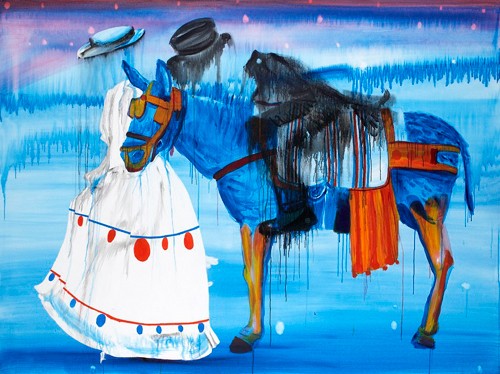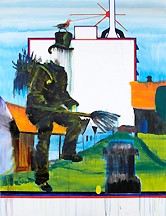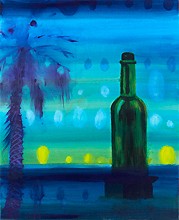
John Kørner, She is Guiding Him, 2005 © John Kørner
The 1st at Moderna: John Kørner
7 problem
1.7 2005 – 14.8 2005
Stockholm
What can Kørner mean by calling his works “problems”? Problems are there to be solved, the saying goes. Art creates or formulates problems. Problems challenge and, hopefully, can lead to creativity. Kørner´s art does not actually appear particularly problematical at first glance. On the contrary, it seems light-hearted, playful and engagingly humorous. It flirts shamelessly with sentimental kitsch. Körner is keen to catch the viewer’s attention with something familiar.
Figurative elements are mixed with abstract, more geometrical forms while painterly, free-flowing ones also collide with stricter, graphic forms. Thus contrasting styles meet in his painting or exist in parallel in the same work. A powerful nuance of yellow forms the ground to many of his paintings. Körner has explained that he uses this yellow colour on account of its ability to communicate. In works with titles like “Man with 44 problems” the problems are represented by spots of paint – that is as abstract signs – rather than by narrative devices.
If one considers John Kørner´s paintings or “problems” it immediately becomes clear that his way of formulating or dealing with “problems” differs radically from that of conceptual art. In conceptual art the idea often comes first and thereafter it controls the entire formation of the work which, in principle, could be undertaken by just anybody, or not at all. Körner is interested in numerous historical, social, political and artistic issues. These provide him with a sort of raw material for developing his ideas. But later, when he is painting, he enters into an intuitive process that is more subject to visual concerns – the matter of how the paintings function as images. Even though he uses sketches done in advance and does not wish to be called expressionist.
Many of the problems that Kørner is concerned with in his painting can be traced to the end of the 19th and beginning of the 20th centuries, to the era of the modernist breakthrough. In his paintings there are traces of the old, pre-industrial world that he could still see the remains of while he was growing up on the Danish island of Lolland. There are chimney-sweeps, kings, horses and trees. But there are also factories which, at the time, perhaps represented the new era but which are now historic buildings that arouse nostalgia. In the Western countries it is not unusual for factory premises to be converted into studios or art galleries. The type of production that previously took place in these factories has, to a large extent, been moved to countries with lower wages. In other paintings we see minarets and men with curved sabres. Körner has explained that he wishes the viewer in some instances to have to ask: why is this a problem?
John Kørner was a sculptor before he began to paint. It still sometimes happens that his way of installing his paintings approaches sculpture or installation. For example, he can use the paintings as screens and create stage sets with them. In some exhibitions the paintings have been converted into stage sets that have been used for performance art or theatre. On several occasions he has collaborated with his wife Kamilla Wargo Brekling who is a set designer. “I am interested in collective experiences like concerts and plays and in feelings that relate to this sort of social situation” he commented in an interview with Timo Valjakka in conjunction with the Carnegie Art Award 2000. At times John Kørner places his paintings in natural surroundings, on the street or in restaurants and clubs. He maintains that this is not institutional criticism or for social reasons. He does it because one can then photograph them and create new pictures which include the paintings. Perhaps one can still sense his communicative thinking and vision behind the moves.
Curator: Magnus af Petersens
The 1st at Moderna is an exhibition programme for contemporary art. The opening is always on the first day of the month, and the exhibitions are in different venues in or outside the museum.


